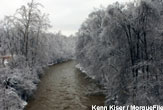New England Rivers Melting Sooner in Spring

Winter in New England just isn't what it used to be. And now scientists have a released new numbers that illustrate the change.
The total number of days of ice on the region's rivers has declined significantly in recent decades and particularly in the spring. The study examined the number of days in which there is enough ice on a river to affect the flow. They looked at rivers in Maine, New Hampshire and Vermont.
The total winter days of ice-affected flow decreased by 20 days from 1936 to 2000 for the average of the nine rivers with records that long, with most of the decrease occurring since the 1960's.
The study, conducted by the U.S. Geological Survey (USGS), was announced Monday and is detailed in the journal Climatic Change.
Of the 16 rivers studied, 12 had significantly earlier spring melts, called "ice-outs," the study found. On average, the ice-out dates became earlier by 11 days from 1936 to 2000, again with most of the change occurring since the 1960's.
"The changes in spring river ice-outs in northern New England are consistent with previous studies," said USGS hydrologist Glenn Hodgkins, the lead author. "The overall evidence of changes is strong and is consistent with warming temperatures in the late-winter and spring in New England in the last 30 to 40 years."
Hodgkins stopped short of blaming global warming.
Sign up for the Live Science daily newsletter now
Get the world’s most fascinating discoveries delivered straight to your inbox.
"There is some evidence of changes consistent with mid-winter warming and little evidence of changes in the fall," he said, "but questions of the broader impact, the cause of this trend, and whether the warmer climate in New England is linked to global climate change are beyond the scope of these studies."
A USGS study released in 2004 showed the annual precipitation in northern New England had switched from snow "significantly in favor of rain" during the last half of the 20th Century.
In July 2003, USGS researchers found that high river flows in winter and spring, which are influenced by snowmelt, came significantly earlier during the 20th Century in northern New England, with most of the 1-to-2-week change occurring over the last 30 years.
Other previous studies reveal earlier last-frost dates and lilac-bloom dates, also suggesting New England's winter weather has become less ferocious.











